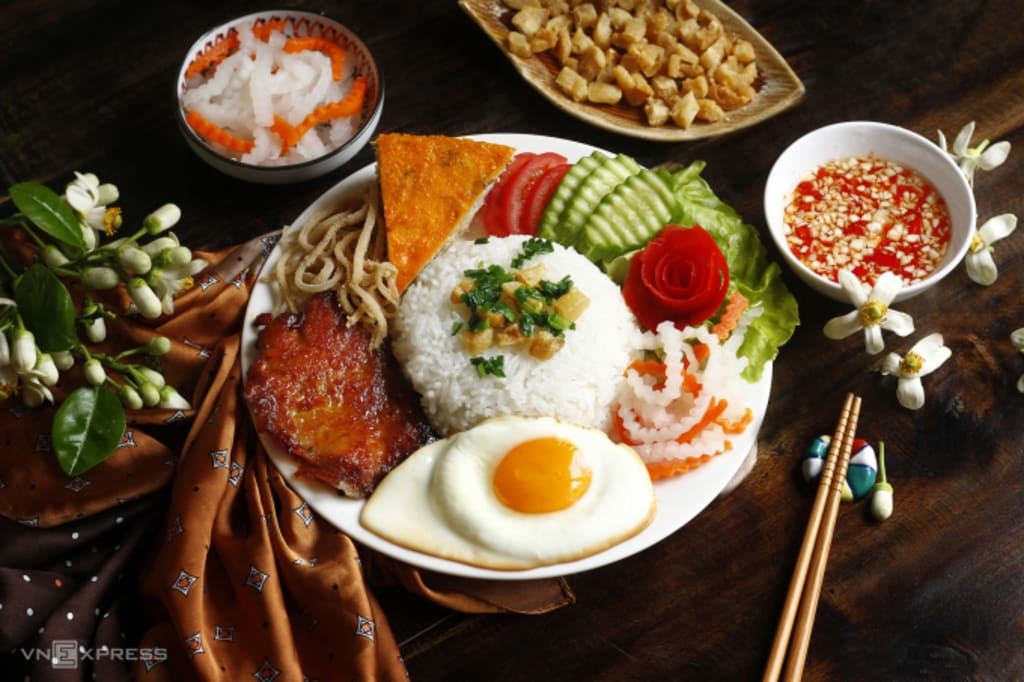Broken rice (Cơm tấm) in USA
Vietnamese cuisine

Yummy yummy yummy
Cơm tấm, a traditional Vietnamese dish, has gained significant popularity in the United States, especially in areas with substantial Vietnamese communities. Known as "broken rice," cơm tấm typically features rice grains that are broken during the milling process, making them smaller and more fragmented than regular rice grains. This dish, once considered a byproduct in Vietnam, has become a culinary staple and is celebrated for its unique texture and versatility.
In its early days, Com Tam was a popular dish among poor rice farmers in the Mekong Delta due to their economic circumstances. During bad rice seasons, these people did not have enough good rice to sell, so they used broken rice to cook. Broken rice is fragments of rice grains broken during the handling processes and was regarded as inferior rice at the time. Broken rice was used solely because it was readily available in the farmers' houses and could fill their stomachs for a long time.
Since Vietnam's urbanization in the first half of the 20th century, Com Tam became popular across Southern provinces, including Saigon. When Saigon was bustling with many people from many countries around the world, food sellers adapted Com Tam to be more suitable for foreign customers like the French, American, Chinese, and Indian. As a result, grilled pork, chả trứng (Vietnamese-style steamed omelet with pork) was added to Com Tam. Also, the portion started being served on plates with a fork instead of in traditional bowls with chopsticks. Nowadays, Com Tam is popular among everyone, and is a "standardized part of the [Saigon] culture", so much that there is a common metaphorical saying (translated from Vietnamese): "Saigon people eat Com Tam like Ha Noi people eat Pho".
History and Popularity in the USA
The migration of Vietnamese people to the United States, particularly after the Vietnam War, brought a wealth of culinary traditions, including cơm tấm. The dish found a welcoming audience, especially in states like California and Texas, which host some of the largest Vietnamese-American populations. Cities such as San Jose, Houston, and Los Angeles boast numerous Vietnamese restaurants that serve authentic cơm tấm.
Ingredients and Variations
Cơm tấm is typically served with a variety of toppings, which may include:
Grilled pork chops (sườn nướng): Marinated in a mixture of fish sauce, sugar, garlic, and other spices before being grilled to perfection.
Shredded pork skin (bì): Thinly shredded pork skin mixed with roasted rice powder.
Steamed pork and egg patty (chả trứng hấp): A savory mix of ground pork, egg, and sometimes vermicelli noodles, steamed to create a firm patty.
Egg meatloaf (chả trứng): A combination of minced pork, mushrooms, and glass noodles, topped with egg yolks and steamed.
Sunny-side-up egg (trứng ốp la): Often added for an extra layer of richness.
Pickled vegetables (đồ chua): Typically pickled carrots and daikon radish, providing a tangy contrast to the rich meats.
Scallion oil (mỡ hành): Chopped scallions cooked in hot oil, drizzled over the rice and meat for added flavor.
Fish sauce (nước mắm): A quintessential Vietnamese dipping sauce made from fish sauce, sugar, lime juice, and chili, which ties all the components together.
Dining Experience
In the U.S., cơm tấm is often enjoyed in both casual eateries and upscale Vietnamese restaurants. Its accessibility and comforting flavors make it a favorite for both quick lunches and relaxed dinners. Some restaurants in Vietnamese enclaves, such as Little Saigon in Orange County, California, have become iconic destinations for cơm tấm enthusiasts.
Cultural Significance
Cơm tấm has transcended its humble origins to become a symbol of cultural identity and pride for Vietnamese Americans. It represents the resilience and adaptability of the Vietnamese community, showcasing how traditional dishes can evolve and thrive in new environments. For many Vietnamese Americans, enjoying a plate of cơm tấm is a way to connect with their heritage and share their culture with a broader audience.
Fusion and Innovation
In recent years, there has been a trend of fusion and innovation in Vietnamese cuisine in the U.S., and cơm tấm is no exception. Chefs are experimenting with new ingredients and presentation styles, integrating elements from other cuisines while maintaining the dish's traditional essence. This evolution ensures that cơm tấm remains relevant and exciting, appealing to new generations and diverse palates.
Conclusion
Cơm tấm's journey from the streets of Vietnam to the diverse culinary landscape of the United States is a testament to the rich cultural exchange that food facilitates. Whether enjoyed in a bustling Vietnamese market or a modern fusion restaurant, cơm tấm continues to delight diners with its unique flavors and textures, embodying the spirit of Vietnamese cuisine and its ability to adapt and flourish in new settings.
About the Creator
Tho Le
My name is Tho Le. My hobbies are music, movies, discover, learning. I have 1 boy who is 15yrs old.
Enjoyed the story? Support the Creator.
Subscribe for free to receive all their stories in your feed. You could also pledge your support or give them a one-off tip, letting them know you appreciate their work.






Comments
There are no comments for this story
Be the first to respond and start the conversation.